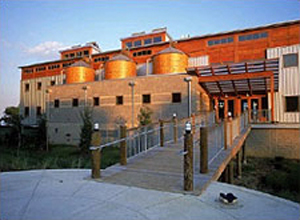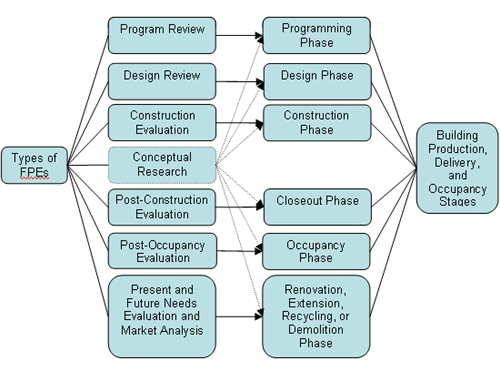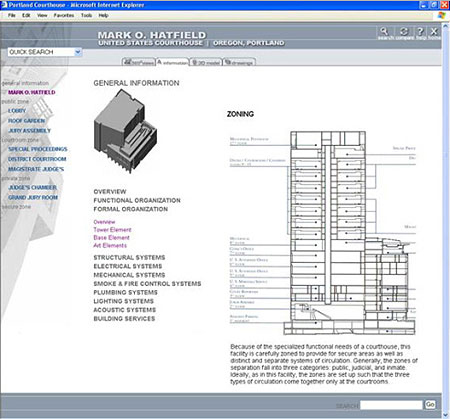Introduction
Within This Page
Facility performance evaluation (FPE) is an extension of what had been called "post-occupancy evaluation." FPE is a continuous process of systematically evaluating the performance and/or effectiveness of one or more aspects of buildings in relation to issues such as accessibility, aesthetics, cost-effectiveness, functionality, productivity, safety and security, and sustainability.
Numerous federal and state agencies are actively involved with FPE, including the U.S. General Services Administration, Naval Facilities Engineering Command, U.S. Courts, U.S. Postal Service, California Department of General Services and many others. The California Department of General Services provides a good model for a FPE program. The goals of the program, as stated in the DGS website, are:
- To better understand the impact of early design delivery decisions on long-term efficiency and effectiveness of buildings, and
- To better understand the impact of building delivery processes and decisions on customer response both initially and over the life cycle of the building.
More recently, WorkPlace 20·20, an initiative of the Public Buildings Service (PBS) Research Program, has incorporated many FPE principles and techniques linking the physical environment, human behavior, and organizational performance to assess and improve workplace performance and effectiveness. There are also several individual cases where FPE has been used to increase long-term efficiency and effectiveness of building facilities. Zion National Park Visitors Center, Springdale, Utah and Chesapeake Bay Foundation (CBF) Merrill Environmental Center, Annapolis, Maryland (Figures 1 and 2) are only two examples of these best practices.

Figure 1: Zion National Park Visitors Center, Springdale, Utah. This facility is part of a transportation system that seeks to reduce resource impacts and enhance the visitor experience using FPE criteria and methods. More
Photo credit: Rob Williamson. NREL PIX 10026.

Figure 2: Chesapeake Bay Foundation (CBF) Philip Merrill Environmental Center, Annapolis, Maryland. An example of a "green" building where issues ranging from energy use to material selection were given serious consideration throughout design and construction of this facility. CBF continues to work with the National Renewable Energy Laboratory (Department of Energy National Laboratory) during a full year of occupancy to evaluate the performance of the building. More
Photo credit: Rob Williamson. NREL PIX 10884.
In this web page, several aspects of FPE are discussed including its definition, typical characteristics, types, phases, data-collection techniques, evaluators, emerging models, benefits, and barriers. In addition, how to conduct a successful FPE, how to develop effective and sustainable FPE programs, and why FPEs are important in the public sector are discussed.
Definition of Facility Performance Evaluation (FPE)
There is no industry-accepted definition of FPE, nor is there a standardized method for conducting a FPE. In an effort to reflect the objectives and goals of FPEs as they are practiced, different terms have been used for FPEs including post-occupancy evaluations (POEs), environmental design evaluations, environmental audits, building-in-use assessments, building evaluation, facility assessment, and building performance evaluations.
POE is the best-known term. POEs that started in the 1960s and 1970s involved individual case studies such as public and student housing. These POEs primarily involved collecting information about occupants and buildings through questionnaires, interviews, site visits, and field observation. POEs were later applied to other facilities such as army barracks, hospitals, prisons, and courthouses. By the mid 1980s, POEs were applied to office buildings and other commercial real estate as well.
Today the scope of evaluations of building performance continues to grow. Although FPE and POE are often used interchangeably in literature and practice, FPE can be significantly different from POE reflecting the changing needs of the real estate industry.
Typical Characteristics of FPEs
Despite the lack of an industry-accepted definition, the following characteristics tend to remain constant in FPEs, and that give them an overall coherence:
- FPEs are generally intended to convey the characteristics of buildings that work well and best, and focus on the ones that should not be repeated in future designs of buildings.
- Facility performance evaluators try to describe rather than manipulate a setting.
- The data-collection for FPEs is usually done in actual settings rather than in the laboratory.
Because of the last two characteristics, FPEs often lack significant experimental controls during the data-collection stages. In the cases where FPE researchers want to reflect a desire to make tight, unequivocal, scientific arguments, and have as much control as possible in a real life situation, they may use field experiments, rather than the laboratory ones. Some field data can however be tested for compliance in a laboratory for more technical FPEs. Click here for a typical FPE/POE example.
Types of FPEs
As shown in Figure 3 below, FPEs can be categorized by the purposes they serve at various stages of building life cycle.

Figure 3: Types of FPEs and their relationships to the building production, delivery, and occupancy stages.
In addition, following Preiser (2001), we can also define FPEs by their activity and resource requirements:
- Brief indicative FPEs aimed at showing the major strength and weaknesses of a particular building;
- More detailed investigative FPEs aimed at showing the causes and effects of environmental issues of building/s; and
- Diagnostic FPEs aimed at correlating environmental measures with subjective user responses.
Phases of FPEs
Typically, there are three phases of FPEs (Figure 4):
-
The planning phase consists of reconnaissance and feasibility studies, and research and resource planning. In this phase, the parameters of the project are established; the schedule, costs, and work force needs are determined; and plans for data collection procedures, times, and amounts are laid out.
-
The conducting phase consists of initiating the on-site data collection processes, monitoring and managing the data collection procedures, and analyzing the data. One important aspect of the conducting phase is to ensure that data being collected meets FPE goals and does not bias the results.
-
The applying phase consists of preparing documents reporting the findings of analysis, recommending actions, and monitoring and reviewing the outcomes of any such action undertaken. Outcomes are important, because they may be used as a feedback to modify and/or improve the next cycle of FPE processes.

Figure 4: Phases of FPEs
Techniques of Data Collection in FPEs
FPEs typically assess the performance of several aspects of buildings and building systems. Techniques commonly used to collect data of building-user relationships, i.e., the FPE/POE techniques, are questionnaires, interviews, field observations, walk-throughs, workshop sessions, photographic surveys, recordings of the use of time, and looking at the physical evidence of use. One key aspect that characterizes FPEs, as opposed to POEs, is that FPEs often involve a much wider range of measures such as technical, economic, and organizational performance. The WorkPlace 20·20 program uses the balanced scorecard (BSC) to organize a range of building-related outcomes (Kampschroer and Heerwagen, 2004).
| FPE measures using the BSC's four-domain approach | |||
|---|---|---|---|
| Finance | Business Process | Customer | Human Capital |
|
|
|
|
| Methods commonly used in FPEs | |
|---|---|
|
|
At present, Internet and other computer-based technologies are used extensively for conducting FPEs and for analyzing the data generated. Web-based surveys are convenient, have low cost of distribution and return, and also make it easy to receive data and check for errors, and give feedback to respondents. The PBS of the General Services Administration (GSA) is working with the Center for the Built Environment (CBE) at the University of California, Berkeley, to develop a set of POE surveys that can be administered over the web. The Naval Facilities Engineering Command (NAVFAC) is also modifying its database to web-enable its POE survey. The Administrative Office of the U.S. Courts and GSA are working with the College of Architecture at Georgia Tech, Atlanta to create interactive websites and databases of several new federal courthouses and innovative offices. These websites allow clients, staff, consultants, project managers, and others to explore completed courthouses, courtrooms, and innovative offices using multi-media, immersive panoramic photographs, plans, computer models, description, and evaluation (Figure 5).

Figure 5: A screenshot of the website currently under development at Georgia Tech as a part of a comprehensive multi-media courts information database.
Computer-based technologies provide several advantages for organizations seeking to integrate facility performance with user assessments. The results from user assessment studies and instrument measures of the physical condition of the building can easily be plotted on floor plans using geographic information systems. The data may then be analyzed individually or as overlays showing the spatial distribution of a range of factors. For example, the users' rating of thermal comfort could be assessed with temperature data and spatial locations. The Disney Corporation and the World Bank both have linked POE data to their geographic information systems for future planning and design purposes. Other computerized techniques of spatial analysis, such as Space Syntax, may allow the users' rating of different psychological, social, and physical aspects of buildings to be related to spatial locations.
Who Should Conduct FPEs?
Ideally, FPEs should be conducted by an independent team of experts, which may include architects, environmental psychologists, mechanical engineers, electrical engineers, facility managers/experts and, when appropriate, fire protection personnel and structural engineers.
In lieu of an independent team of experts, several individuals and groups are available to perform FPEs:
- The architectural and/or engineering firms may conduct an evaluation in the pre-design phase,
- The architect/engineer or client may hire an individual consultant or professional organization to do pre-design and/or post-occupancy evaluations,
- An academic group may initiate and perform FPEs to develop a knowledge base on a set of social and psychological issues, evaluation methods, and/or building types, and/or
- In-house facility experts may do their own FPEs.
Organizations undertaking FPEs should weigh the pros and cons of each group of evaluators to ensure the best possible outcomes.
Emerging Models of FPEs
Among the emerging models of FPEs,
-
Quick-response surveys are performed to support settling-in and fine-tuning of buildings two to three months after occupancy. The study process generally includes a brief user questionnaire, structured touring interviews and feedback to users and managers. The aims of these quick-response studies are to support organized feedback and prioritize ways to increase client comfort;
-
Decision-focused evaluations provide input into specific important programming or design decisions, diagnose troubled projects, and/or assess new programs, technologies and design approaches;
-
Evaluations for design guides establish key decisions and components for repeated building types, and identify best research and practices;
-
Evaluations for creating a knowledgebase link facilities decisions to key business drivers, make evaluation information easily accessible, and allow stakeholders to suggest lessons learned;
-
Evaluations to improve building delivery and managements systems suggest ways to create improved mechanisms for communications across stakeholders, to empower stakeholders, and to encourage participation through incentives.
Benefits of FPEs
There are several potential short, medium, and long-term benefits of FPEs:
- Short-term benefits are related to immediate design decisions, and facility maintenance and management issues,
- Medium-term (3– to 5–yr period) benefits are related to generating useful information for future projects, and
- Long-term (10– to 25–yr period) benefits are related to improving the long-term performance of buildings and to justifying major expenditures.
Barriers to FPEs
Despite their benefits, there are several professional, institutional, cultural, and technical/technological barriers to wider adoption of FPEs in the real estate industry. For example:
- There is generally no money set aside for FPEs.
- Sometimes, FPEs may require a considerable amount of time.
- Organizations may not always have people with the necessary skills to conduct FPEs.
- Professionals often do not like to have their work judged by other professionals.
- There are always difficulties involved in establishing a clear link among user assessments, positive outcomes, and the physical environment.
- The relationship between facility design and FPEs is complex and fuzzy.
How to Conduct a Successful FPE
Despite these barriers, a wide range of organizations from Disney to GSA to the U.S. Courts have developed successful FPE programs. An evaluator may need to take the following measures to conduct a successful FPE:
-
Develop a clear statement about what the organization wants to achieve by conducting and applying a FPE. The links between evaluations and stated requirements have to be explicit and easy to trace.
-
Identify resources available to carry out a FPE, matching data collection and analysis to the available time and budget.
-
Garner support from high levels in the organizations to signal the importance of the project to respondents and/or occupants.
-
Determine appropriate methodology. The approach to a one-of-a-kind case study may be different from a standardized approach.
-
Inform respondents and/or occupants about the purpose of their involvement and how the data will be used.
-
Establish performance goals based on existing as well as changing trends.
-
Interpret and synthesize FPE findings in useful ways for the likely users.
-
Make results widely available for action by different groups of stakeholders. In addition to the written reports, videos, DVDs, and websites may be useful in this regard.
-
Use FPE findings to facilitate organizational learning to improve building performance under routine conditions and to respond to changing conditions quickly and effectively.
-
Suggest ways to consolidate FPE results and lessons learned as organizational memory, and develop an effective method to disseminate the consolidated data. A record of past projects may serve as a good justification for future FPEs.
Making Effective and Sustainable FPE Programs
By providing opportunities for improvement of various stages of building processes, and of the relationships between environment and behavior, and among owners, users, and designers, FPEs have a significant role to play in the building industry. Ideally, one would like to see FPEs carried out systematically on a wide variety of buildings that cover a significant range of issues for different stakeholders. As building control systems and FPE techniques become computerized and continue to evolve, conducting FPEs, managing FPE data, and sharing lessons learned should become easier and more cost-effective.
However, in order to overcome some of the barriers to their widespread use, FPEs need to be incorporated as a necessary step in the project production and delivery, and portfolio and asset management processes. In addition, professional, organizational, and technical issues that traditionally have limited the effectiveness of FPEs need to be addressed, and that may require major structural and organizational changes with respect to how FPEs are defined and conducted.
| Measurers to create sustainable FPE programs |
|---|
|
FPEs in the Public Sector
The public sector is an obvious setting for continuous FPEs because:
-
Unlike the private sector, the agencies in the public sector often have the "cradle-to-grave" responsibility of their buildings. They either occupy the buildings they produce or have long-term commitments to clients who do.
-
They have large inventories of buildings of similar types, production, and maintenance of which may benefit enormously from a FPE knowledgebase built over a period.
-
A steady commitment to FPEs may provide public agencies a real competitive advantage in a customer-driven market.
-
Mutually beneficial collaborative FPE programs in the public sector can have a potential to significantly impact over a multi-billion dollar federal construction industry and the daily work life of millions.
The Federal Facilities Council (FFC), a cooperative association of 21 federal agencies with interests and responsibilities for large inventories of public buildings, has been constantly seeking ways to increase collaboration among its participant agencies. A coalition of seven large state and federal agencies, known as the FPE Working Group, has also been developing a collaborative FPE program since 2002. This group has realized that in order to overcome the cultural, organizational, and technical barriers within each participant organization as well as the cross-organizational barriers, it is necessary:
- To establish common metrics and procedures for measuring a wide range of performance aspects;
- To develop cost-effective and valid ways of collecting and sharing data;
- To create FPE models for standard as well as project-specific problem solving;
- To develop baselines, benchmarks, and comparisons; and
- To build on lessons learned from previous FPE programs.
| Agencies included in the FPE Working Group |
|---|
|
Additional Resources
Publications
- ASTM Standards on Whole Building Functionality and Serviceability by American Society for Testing and Materials (ASTM). West Conshohocken, PA: ASTM, 2000.
- Building Evaluation Technique by Baird, G., Gray, J., Isaacs, N., Kernohan, D., and McIndoe, G. Wellington. New Zealand: McGraw-Hill, Inc., 1996.
- Environmental Design Evaluation by Friedmann, A., Zimring, C. & Zube, E. New York: Plenum, 1978.
- Learning from Our Buildings: A State-of-the-Practice Summary of Post-Occupancy Evaluation by Preiser, W. Federal Facilities Council. National Academy Press, 2001.—The evolution of post-occupancy evaluation: toward building performance and universal design evaluation.
- Methods in Environmental and Behavioral Research by Bechtel, R. B., Marans, R. W., & Michelson, W. (Eds.). New York: Van Nostrand Reinhold Company, 1987.
- Post-Occupancy Evaluation by Preiser, W., Rabinowitz, H. & White, E. T. (Eds.) New York: Van Nostrand Reinhold Company, 1988.
- Post-Occupancy Evaluation: An Overview in Environment and Behavior 12: 429-51 by Zimring, C. & Reizenstein, J. E. 1980.
- Proceedings of the 1st-34th Annual Conferences of the EDRA. Edmond, OK: Environmental Design Research Association (EDRA).
- Serviceability Tools, Volume 3—Portfolio and Asset Management: Scales for Setting Requirements and for Rating the Condition and Forecast of Service Life of a Facility—Repair and Alteration (R&A) Projects by Davis, G. et al. Ottawa, ON: International Centre for Facilities, 2001.
- "Strategic Post-Occupancy Evaluation" Paper for the International Conference on Post-Occupancy Evaluation: Closing the Loop by K. Kampschroer and J. Heerwagen. Windsor, UK: 2004.
- User Participation in Building Design and Management by Kernohan D., Gray, J., Daish, J., & Joiner, D. Oxford: Butterworth-Heinemann Ltd., 1992.
- "Working with the Performance Approach in Building" in CIB Report, Publication 64 by Gibson, E.J. Rotterdam, Holland: 1982.








